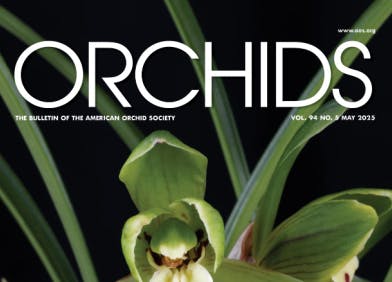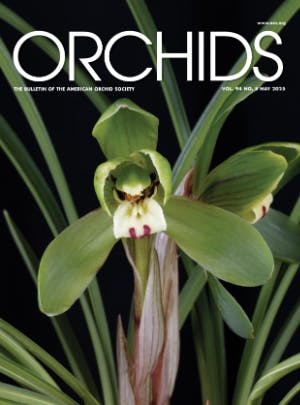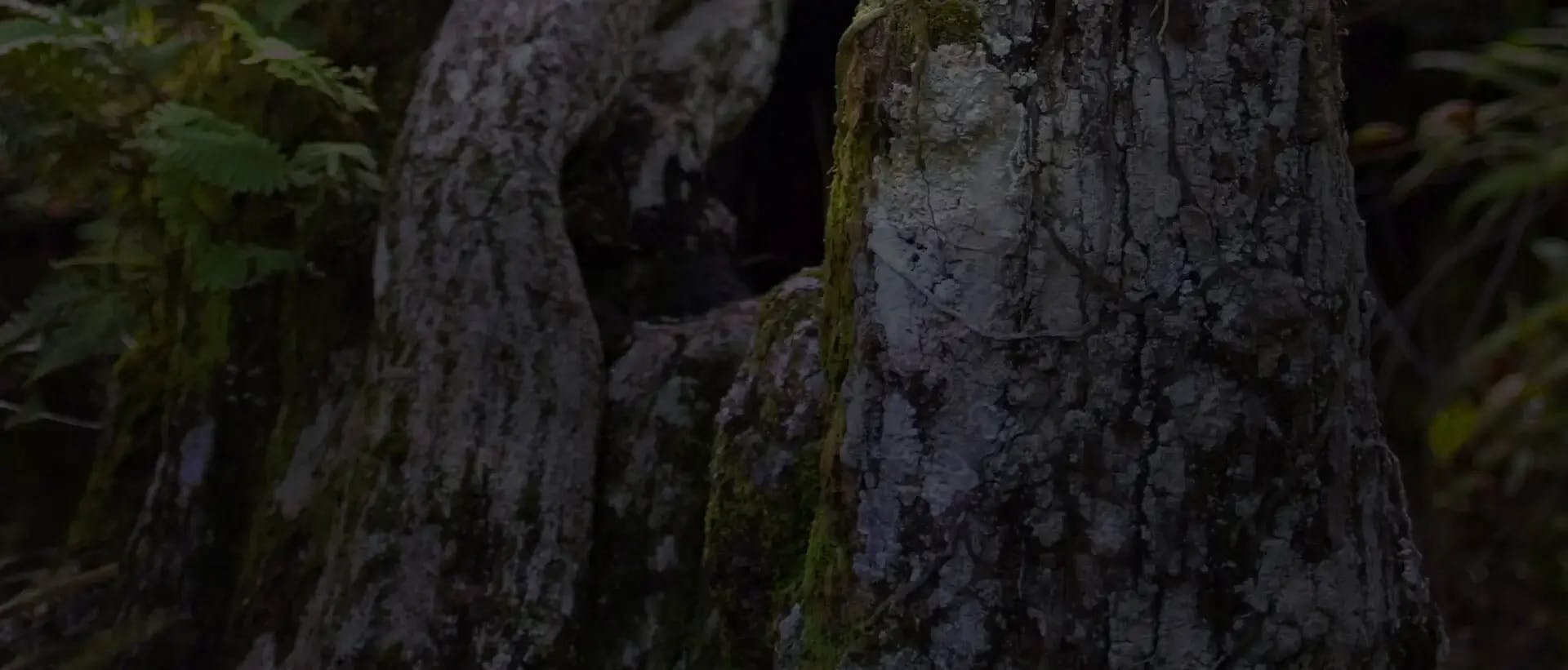
Over the next couple of months, we’ll look into the factors that facilitate (or hinder) flowering in a number of the orchids we grow and, spoiler alert, it has almost nothing to do with fertilizer. Even without fertilizer, plants that are sufficiently mature enough to flower can be brought into flower.
In general, there are two main components needed to help make our plants bloom. The first is an energy reserve. Plants that do not have sufficient energy to flower, will not flower! They need to be big enough and have some extra reserve energy, otherwise they expend what energy they have in growing or, in some cases, just surviving. The second component is an extensive collection of environmental factors that plants have evolved to trigger flowering at appropriate times in their natural habitat. Some of these, such as day length, can be mitigated by the creation of hybrids that have ancestors with different blooming seasons, while others can be much harder to overcome. These are the things we need to address in the plants we grow.
[1] Fertilizer — amount, frequency, and type — is one of the least important factors in blooming orchids. None of the plants on this bench has ever been fertilized, and the oldest plants are at least 15 years old. They will not win awards but continue to grow and flower every year.

First, ask if your plant is physically mature enough to bloom. In seedlings, most of their energy is spent on growth, and a little on maintenance. In nearblooming-sized (NBS) plants, significant energy will still be spent on growth, but they are beginning to build a little reproductive reserve. Blooming-sized (BS) plants have yet more reproductive reserve, while specimen plants often have both lots of growth potential and reproductive reserve. So-called NBS plants do not all have the capacity to flower. Only about 10–15% of these are strong enough to bloom in the first year. About 50%+/- will bloom in the second year, and most can be expected to have flowered by the end of the third year. It is a good idea to mark your tag with the year you bought the plant so you can keep track of this. In monopodial orchids, you need a sufficiently mature stem to even have the potential to bloom. For instance, in Phalaenopsis, the first inflorescence almost always comes from the fifth or sixth mature leaf axil (do not count the most recently emerging leaf).
[2] Reprinted from the article by Ray Barkalow entitled “Making Plants Bloom” (Orchids 89(5):346 347) graphically illustrates that, as a plant grows, its acquisition of total resources increases, and the amount utilized to maintain existing growth (mauve) increases proportionally. Resources committed to growth (green) are a significant fraction of the total early on but decrease in proportion to the total as the plant matures, allowing the resources committed to blooming and reproduction (red) to increase significantly.

Roots are critical to providing the copious water our plants need to grow! Water does not kill roots, but lack of air exchange does. If you do not believe that, look at the cattleya backbulb propagation pictured here. I root all my cattleya backbulbs in standing water. It is almost foolproof, and they do not rot as long as there is ample surface area for gas exchange and the water does not become stagnant. If you have stagnant, wet potting mix with no air exchange the roots will rot. A strong root system means more efficient uptake of water, which leads to more efficient nutrient utilization and growth. More efficient water uptake means more energy to spend on flowering. Learn to grow good root systems! Check the root system of newly acquired plants by gently removing them from their pots. Be sure to give your plants enough water. Too often, plants do not get enough because people are afraid to overwater. This dehydration stresses plants, and they will not flower under those conditions.
[3] Reprinted from the article by Ray Barkalow entitled “Making Plants Bloom” (Orchids 89(5):346 347) graphically illustrates that with poor culture, the acquisition of resources may be reduced, but the expenditure of them to maintain the health of the plant is unchanged. The resources expended on new growth are also reduced, but the net result is that there is less available for reproduction, reducing blooming.

Why does a physically mature plant fail to flower? This usually happens when you are not providing one or more environmental factors that the plant needs.
[4] After exhausting other efforts to save her Cattleya labiata f. coerulea ‘Natural World’ AM/ AOS, Birute Anne Vileisis successfully salvaged the last remnant by sprouting and rooting it in water.

TEMPERATURE
The diurnal variation between day and night temperatures is important. Absolute day or night temperatures are also a factor. Some orchids need a period of low temperatures, typically at night, to induce flowering. Without this temperature requirement being met, the plant will not flower.
[5] This young Phalaenopsis is too young to bloom. First inflorescences almost always come from the fifth or sixth mature leaf axil. These leaves in this example have not reached maturity, and the plant could likely flower after another growing season. Note that leaf #2 has been lost, but the remnant leaf base can be seen behind the root.

DAY LENGTH CHANGES
Some orchids are critically dependent on the natural changes in day length (and night length) across the year. Plants that naturally bloom only in the spring are typically responding to having passed the shortest daylight of the year, and the days are getting longer. Fall bloomers are just the opposite of that. This happens in many cattleyas, especially species and simple hybrids. It is easy growing under lights to fail to provide these changes and the result may be plants not blooming.
LIGHT LEVEL VARIATION
Seasonal variation in light levels can also be a required environmental trigger for some plants. The summer sun is more intense than the winter sun, thus providing an additional trigger for blooming. Many plants from monsoonal climates are brought into flowering just before or just after the monsoons — often directly related to changes in light level.
WATER AVAILABILITY
Plants from climates with a pronounced dry period evolve to need that dry rest to flower well. Many deciduous dendrobiums flower poorly or not at all if not provided a very dry, often cool rest period. It is not just orchids. The South African Rain Bush (Myrothamnus flabellifolius) has the uncanny ability to flower two or three days before rains come. The reason for this is not well understood, but it is clear that the plant is reacting to some change in its environment.
LEFT
Some orchids are adapted to flowering following a significant increase in the day-night temperature differential and a drop in the absolute night temperature. These data represent the habitats of Dendrobium nobile and Dendrobium lindleyi, both of which are brought into bloom following day temperatures below 80 F (27.7 C), nights below 50 F (10 C), and, importantly, a day-night differential greater than 25 F (13.9 C).

RIGHT
Daylength variation across the year varies dramatically with increasing latitude. Orchids from habitats north and south of the equator may have a strong seasonal adaptation with regard to flowering.

LEFT
Flowering in some orchids depends on an increase in light intensity or the number of clear days in a month. Flowering in Dendrobium nobile and Dendrobium lindleyi not only depends on day/night temperature changes but also on light intensity (flowering occurs during the clearest time of the year).

RIGHT
Water availability can also be a triggering factor in the flowering of some orchids. The flowering season for Dendrobium nobile and Dendrobium lindleyi occurs not only during the brightest and coolest time of the year, but also during the driest, when little to no rain falls in their native habitats.

How do I mix and match these variables to get my plants to bloom? This is where knowing the names of the plants you are trying to grow can be important. Is it a species or hybrid? Suppose the name that follows the genus is all lowercase. In that case, it tells you it is a species, while names that begin with capital letters designate hybrids (Cattleya labiata versus Cattleya Gertrude Hausermann). Once you know the name, you can research the species habitat and blooming seasons (if it is a hybrid, you can determine the species that make up its background and then research those species). So, if you determine that your orchid is a winter-blooming purple cattleya, it is, most likely, going to be brought into bloom triggered by the progression of days getting shorter through the winter solstice. A spring-blooming Cattleya would be triggered by the days getting longer after the winter solstice.
Next month, we will look at the environmental triggers involved in flowering some of the more common genera in cultivation.
— Ron McHatton, Chief Education and Science Officer, Editor (email:rmchatton@aos.org).












